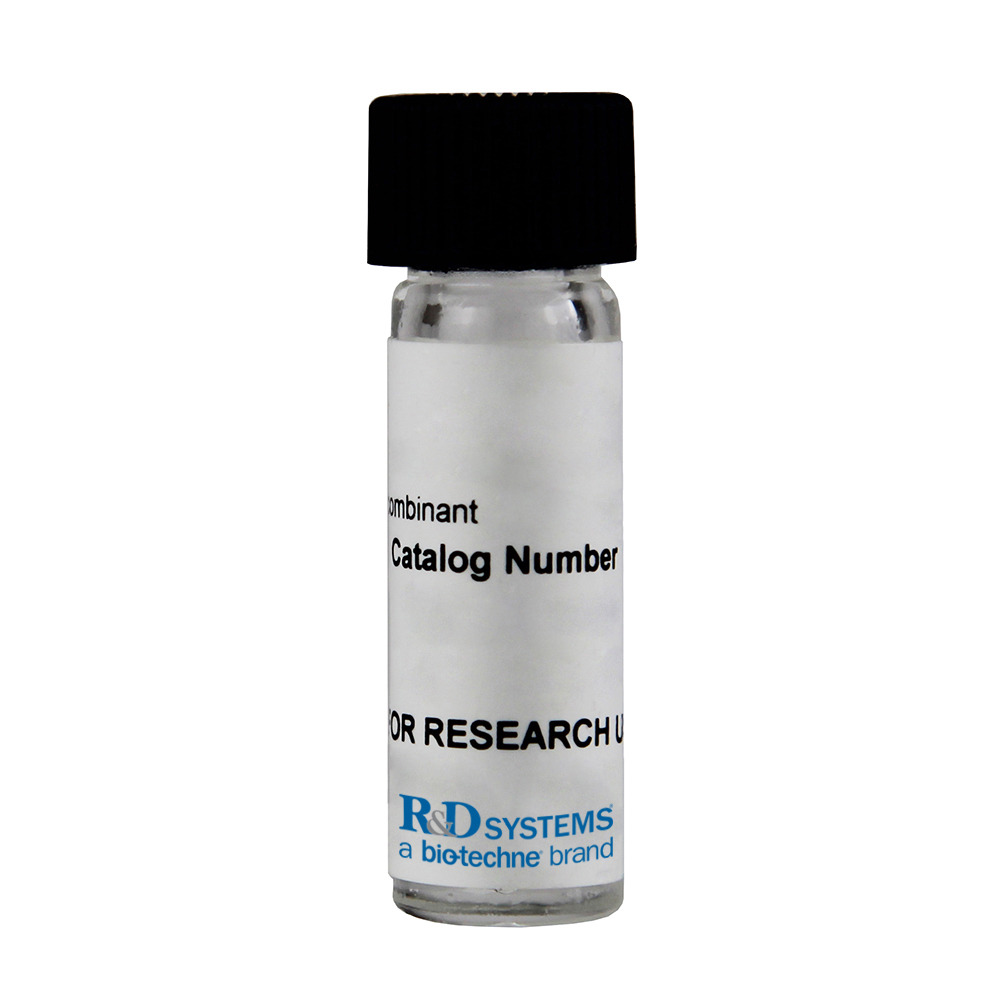Recombinant Human Lefty-A Protein
R&D Systems, part of Bio-Techne | Catalog # 746-LF

Key Product Details
Product Specifications
Source
| Mouse Lefty-1 Propeptide (Leu22-Arg77) Accession # Q64280 |
HHHHHH |
Human Lefty-A (Phe78-Pro366) Accession # O00292 |
| N-terminus | C-terminus | |
Purity
Endotoxin Level
N-terminal Sequence Analysis
Predicted Molecular Mass
SDS-PAGE
Activity
The ED50 for this effect is 0.5-3 µg/mL.
Formulation, Preparation and Storage
Carrier Free
What does CF mean?CF stands for Carrier Free (CF). We typically add Bovine Serum Albumin (BSA) as a carrier protein to our recombinant proteins. Adding a carrier protein enhances protein stability, increases shelf-life, and allows the recombinant protein to be stored at a more dilute concentration. The carrier free version does not contain BSA.
What formulation is right for me?In general, we advise purchasing the recombinant protein with BSA for use in cell or tissue culture, or as an ELISA standard. In contrast, the carrier free protein is recommended for applications, in which the presence of BSA could interfere.
Carrier: 746-LF
| Formulation | Lyophilized from a 0.2 μm filtered solution in PBS with BSA as a carrier protein. |
| Reconstitution | Reconstitute at 500 μg/mL in sterile PBS. |
| Shipping | The product is shipped at ambient temperature. Upon receipt, store it immediately at the temperature recommended below. |
| Stability & Storage | Use a manual defrost freezer and avoid repeated freeze-thaw cycles.
|
Carrier Free: 746-LF/CF
| Formulation | Lyophilized from a 0.2 μm filtered solution in PBS. |
| Reconstitution | Reconstitute at 0.5 mg/mL in sterile PBS. |
| Shipping | The product is shipped at ambient temperature. Upon receipt, store it immediately at the temperature recommended below. |
| Stability & Storage | Use a manual defrost freezer and avoid repeated freeze-thaw cycles.
|
Background: Lefty-A
Lefty was first identified in a screen for undifferentiated cell-specific cDNAs from the P19 mouse embryonal carcinoma cells. Its mRNA expression on the left side of the developing embryo earned the name “Lefty”. The human orthologue was initially identified as Ebaf, Endometrial Bleeding-Associated Factor. Two genes exist in mouse (Lefty-1 and Lefty-2) and two in humans (Lefty-A and Lefty-B). By amino acid sequence, human Lefty-A and -B are more similar to each other (96%) than to either Lefty-1 or -2 in the mouse (81 - 82% identical). Lefty contains the six cysteine residues that are conserved among TGF-beta related proteins and that are necessary to form the cysteine-knot structure. However, Lefty is distinct from other family members in that it has two RXXR cleavage sites, a longer carboxy terminal sequence, and it lacks the cysteine residue required for intermolecular disulfide linkage. Thus, mature forms of Lefty are larger than mature forms of other TGF-beta -related proteins.
Lefty homologues have been identified in other vertebrate organisms including chick, frog, and zebrafish. Although the amino acid sequence identity is not well conserved among vertebrate species, the expression pattern of Lefty on the left side is well conserved. Furthermore its function in patterning left-right asymmetry of the developing organ systems such as the heart and lung is consistent in all vertebrate species examined. Lefty acts as an antagonist to Nodal signaling, potentially by competing for binding to a common receptor.
References
- Meno, C. et al. (1996) Nature 381:151.
- Kosaki, K. et al. (1999) Am. J. Hum. Genet. 64:712.
- Schier, A.F. and M.M. Shen, (1999) Nature 403:385.
- Branford, W.W. et al. (2000) Dev. Biol. 223:291.
- Tabibzadeh, S. et al. (2000) J. Clin. Endocr. Metab. 85:2526.
- Ulloa, L. et al. (2001) J. Biol. Chem. 276:21387.
Alternate Names
Entrez Gene IDs
Gene Symbol
UniProt
Additional Lefty-A Products
Product Documents for Recombinant Human Lefty-A Protein
Product Specific Notices for Recombinant Human Lefty-A Protein
For research use only
